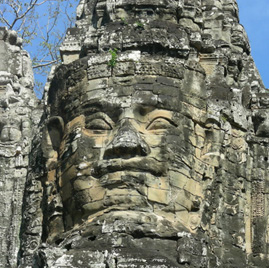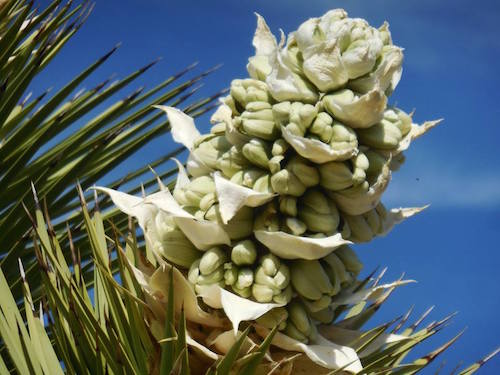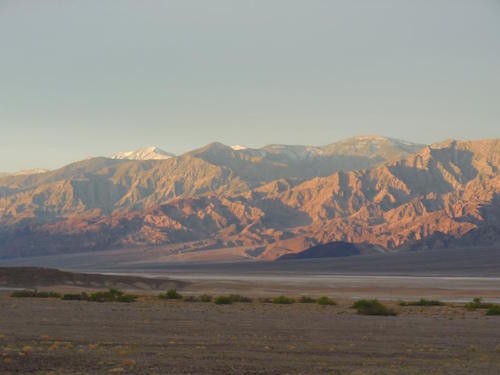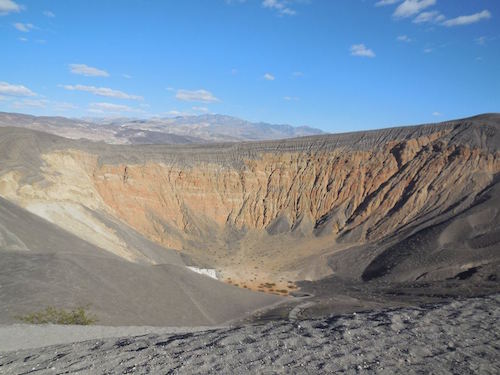|

 Karen's Perspective on Traveling Alone Karen's Perspective on Traveling Alone






















|
Experiencing Joshua Tree and Death Valley in the season of the spring wildflowers has been on my bucket list for about 20 years. I went in early March which proved to be the perfect time for most wildflowers in Death Valley, although just a week or so before prime blooming season for the Joshua trees. The trees have enormous pineapple shaped blooms that are almost pure white and exude a tropical aspect in the midst of almost pure dryness. I had flown to Palm Springs and rented a car to make the drive north to Joshua Tree. On the way I stopped along the western side of the park at Big Morongo Canyon. The natural spring fed desert oasis here is one of the 10 largest cottonwood and willow riparian habitats in California. It's a pleasant side trip and I spotted a least flycatcher and western kingbird before having lunch and seeing two other birders, asked them what they had seen. They were from the frozen midwest and come here annually to enjoy the sun and the birds and told me where to look for more species and were duly impressed when I saw an uncommon bird, a Lawrence's goldfinch in the direction they pointed me.
 I had booked a cozy remote cabin 10 miles outside of Joshua Tree on airbnb and its solitude was nearly complete with incredible wide vistas and even a croquet set for the sandy landscape. Sunsets and sunrises were spectacular the first 24 hours and I felt like a true western homesteader, albeit one with solar panels and a sturdy water reservoir. I took a long afternoon nap, then drove into the park for the other worldly shapes that the Joshua trees (named by the Mormons) take on at dusk. A quick walk at Barker Dam took me past some unusual granite boulders, called Wonderland of Rocks. Boulders were used to make the dam over 100 years ago but only a small amount of water remained, even though the park had gotten a bit more rainfall that northern CA. The quiet and peacefulness seeped into my bones and seemed to call me to listen and relax and start soaking in the pull of the desert. I spent the evening re-reading the short story called Bad Graft by Karen Russell. She captures the mystery and the impact of the park in a few exquisite sentences: The boy could scarcely believe the size of the boulders, clustered under the enormous sun like dead red rockets awaiting repair, or the span of the sky, a cheerfully vacant blue dome, the desert's hallucinatory choreography achieved through stillness, brightness, darkness, distance - and all of this before noon.
I had booked a cozy remote cabin 10 miles outside of Joshua Tree on airbnb and its solitude was nearly complete with incredible wide vistas and even a croquet set for the sandy landscape. Sunsets and sunrises were spectacular the first 24 hours and I felt like a true western homesteader, albeit one with solar panels and a sturdy water reservoir. I took a long afternoon nap, then drove into the park for the other worldly shapes that the Joshua trees (named by the Mormons) take on at dusk. A quick walk at Barker Dam took me past some unusual granite boulders, called Wonderland of Rocks. Boulders were used to make the dam over 100 years ago but only a small amount of water remained, even though the park had gotten a bit more rainfall that northern CA. The quiet and peacefulness seeped into my bones and seemed to call me to listen and relax and start soaking in the pull of the desert. I spent the evening re-reading the short story called Bad Graft by Karen Russell. She captures the mystery and the impact of the park in a few exquisite sentences: The boy could scarcely believe the size of the boulders, clustered under the enormous sun like dead red rockets awaiting repair, or the span of the sky, a cheerfully vacant blue dome, the desert's hallucinatory choreography achieved through stillness, brightness, darkness, distance - and all of this before noon.
Seeing the Big-horned sheep
I studied the night sky, wrapped up in a blanket and pondered the meaning of life, right on cue with what most desert dwellers must experience. I slept like a desert boulder and was ready the next morning to tackle Ryan Mountain, a 5470 foot view of the surrounding mountain and valleys including some snow on top of San Gorgonio and San Jacinto looking west from the summit. The 700 foot climb seems rather steep in places and right when I was getting a bit winded, a woman making the descent told me there were big horned sheep just around the bend. Big horned sheep! My heart raced as it always does at the mention of megafauna.  I had visited Joshua Tree several years earlier and had never seen the sheep although I had scanned the mountainsides repeatedly with my binocs. After a short climb, there they were in all their glory and so many! Lots of females with 7 young ones all eating on the tender shoots between rocks. Their coats camouflaged them perfectly except for the white hindquarters and white stripe down the backs of their thin and sturdy legs. Right at that moment the herd made their prancing dancing way across the path ahead, eyeing us humans with a bit of curiosity but no sense of danger. I'm not sure why seeing megafauna is so thrilling but its attraction for me is undeniable. One of the most memorable days in my life was the chance encounter with a mountain lion in Pinnacles State Park. I had not been sure it was a mountain lion when I saw a swish of a long tail around a corner and jogged toward it to be sure, a no-no according to the park rangers but instinctual for a curiosity seeker like myself. I had visited Joshua Tree several years earlier and had never seen the sheep although I had scanned the mountainsides repeatedly with my binocs. After a short climb, there they were in all their glory and so many! Lots of females with 7 young ones all eating on the tender shoots between rocks. Their coats camouflaged them perfectly except for the white hindquarters and white stripe down the backs of their thin and sturdy legs. Right at that moment the herd made their prancing dancing way across the path ahead, eyeing us humans with a bit of curiosity but no sense of danger. I'm not sure why seeing megafauna is so thrilling but its attraction for me is undeniable. One of the most memorable days in my life was the chance encounter with a mountain lion in Pinnacles State Park. I had not been sure it was a mountain lion when I saw a swish of a long tail around a corner and jogged toward it to be sure, a no-no according to the park rangers but instinctual for a curiosity seeker like myself.
 One of the pleasures of Joshua Tree and its surroundings is birdwatching and dinner at 29 Palms Oasis Inn in the hamlet of 29 Palms on the north side of the park. Years before I had stayed in their cabins along the oasis and the food and service were still delightful with some decent live music along the outdoor pool.
One of the pleasures of Joshua Tree and its surroundings is birdwatching and dinner at 29 Palms Oasis Inn in the hamlet of 29 Palms on the north side of the park. Years before I had stayed in their cabins along the oasis and the food and service were still delightful with some decent live music along the outdoor pool.
Tecopa Hot Springs and Death Valley
The drive from Joshua Tree to Death Valley takes about 4 and 1/2 hours and a recommended stop is halfway between at Tecopa Hot Springs. A sign from the road points you there. Pass the place for the indoor paid springs and head out to the clothing optional variety. There were some crusty locals and a group of bathing suited Japanese tourists here but there is enough room to find your own seclusion which I managed to do. It is just by the north side of the road side NW of the intersection off Tecopa Hot Springs Road and Furnace Creek Road. You will see a sign asking people to protect the environment. Just park your car by the road and walk north for a short distance. Driving to Death Valley you come upon the famous road stop Amargosa Opera House and Hotel. It's a pretty run down looking place by now but folks who went on the paid tour said it was interesting. I stopped by to take a peak inside the lobby but decided I'd better get a move on as I was camping in Death Valley and hoped to get my tent up before dark. Just after entering the park, I climbed for the view at Zabriskie Point, a multicolored vista of the "badlands" which have a varied visual texture.  I camped for 3 nights at Stovepipe Wells, placing my tent just beyond the signed boundary, all the better to get away from the noise of car doors. Stovepipe Wells is a great location as there is a tasty restaurant and bar as well as a welcome swimming pool and bathhouse which you can pay $4 a day to access. One day after hiking and driving, I also went up to check out the fancy schmanzy Furnace Creek Lodge and conveniently brought my swimsuit for a nice dip and lounge with their cushy towels and lounge chairs. There is no code and you can push the gate open and just act like you belong, a perk for the bold and fearless like moi. I enjoyed the easy but colorful climb through Mosaic Canyon with its slickrock and a hot climb in Desolation Canyon which I would have enjoyed more if I had walked it at the beginning or end of the day instead of high noon when it was too hot for comfort. Seeing fields of desert gold flowers and a smattering of the delightfully pink desert five spot were my wildflower highlights. I went online before leaving to check and see where the best showings were. I camped for 3 nights at Stovepipe Wells, placing my tent just beyond the signed boundary, all the better to get away from the noise of car doors. Stovepipe Wells is a great location as there is a tasty restaurant and bar as well as a welcome swimming pool and bathhouse which you can pay $4 a day to access. One day after hiking and driving, I also went up to check out the fancy schmanzy Furnace Creek Lodge and conveniently brought my swimsuit for a nice dip and lounge with their cushy towels and lounge chairs. There is no code and you can push the gate open and just act like you belong, a perk for the bold and fearless like moi. I enjoyed the easy but colorful climb through Mosaic Canyon with its slickrock and a hot climb in Desolation Canyon which I would have enjoyed more if I had walked it at the beginning or end of the day instead of high noon when it was too hot for comfort. Seeing fields of desert gold flowers and a smattering of the delightfully pink desert five spot were my wildflower highlights. I went online before leaving to check and see where the best showings were.
A drive to Scotty's Castle is a must see as prospector "Death Valley Scotty" claimed this elaborate Spanish-style mansion was built from gold from his fictitious mine. In reality, it was the 1920's vacation home of his rich friends and the story of how it came to be is one of the great swindling stories of the west. The excellent living history tour of the richly furnished interior is worthwhile. The great room reminds me of a miniature of the Ahwahnee Hotel lodge with its wooden detail and Native American decor. While on the north end of the park, I stopped by to see the relatively recent Ubehebe Crater, formed just a few hundred years ago by a massive volcanic explosion caused by magma mixing with an underground spring.
Ash Meadows and Devil's Hole
On the way to catch my flight out of Las Vegas, I had just enough time to spend about an hour at Ash Meadows and Devil's Hole, a spanking new national refuge area and Visitor's Center.  I didn't have time to visit the Visitor's Center and decided to just see the sights and what sights they were just 90 miles west of Las Vegas. First I spotted a ferruginous hawk, only the second time in my life of seeing one. Ash Meadows National Wildlife Refuge is a biodiversity hot spot and a haven for rare plants and animals; an incredible story of survival for an ancient species of fish. It is the last remaining oasis in the Mojave Desert, and location of the famous Devil's Hole. I was able to see 3 or 4 very endangered pupfish in Devil's Hole, a tiny water-filled limestone cavern. The newly constructed boardwalk takes you there and it's super isolated with not a single other soul there on the morning I was there. I didn't have time to visit the Visitor's Center and decided to just see the sights and what sights they were just 90 miles west of Las Vegas. First I spotted a ferruginous hawk, only the second time in my life of seeing one. Ash Meadows National Wildlife Refuge is a biodiversity hot spot and a haven for rare plants and animals; an incredible story of survival for an ancient species of fish. It is the last remaining oasis in the Mojave Desert, and location of the famous Devil's Hole. I was able to see 3 or 4 very endangered pupfish in Devil's Hole, a tiny water-filled limestone cavern. The newly constructed boardwalk takes you there and it's super isolated with not a single other soul there on the morning I was there.
|
|



 Karen's Perspective on Traveling Alone
Karen's Perspective on Traveling Alone


 Karen's Perspective on Traveling Alone
Karen's Perspective on Traveling Alone